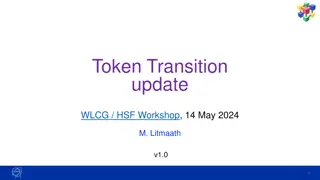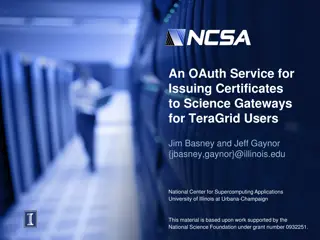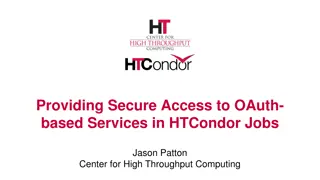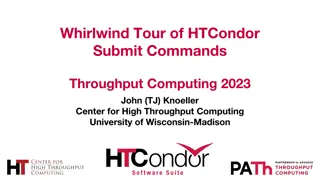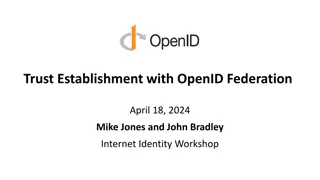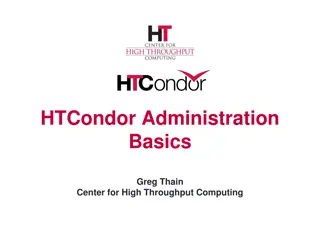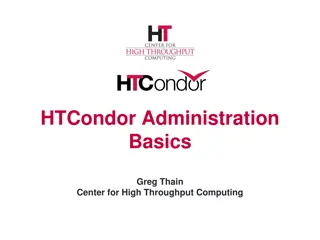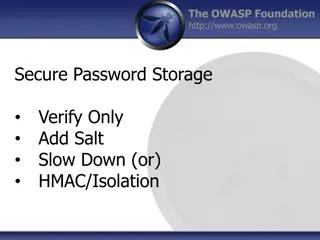Integrating Hashicorp Vault with HTCondor for Secure Oauth Credential Management
Exploring the use of token-based authentication over X.509 certificates for improved security in HTCondor workflows. The transition to tokens offers enhanced control and flexibility, with a focus on utilizing JWTs and Scitokens. Leveraging Hashicorp Vault alongside HTCondor streamlines the management of credentials and access tokens, providing secure storage and automation capabilities. This shift towards tokens enhances usability both within and outside HTCondor, optimizing user authentication and authorization processes.
Download Presentation

Please find below an Image/Link to download the presentation.
The content on the website is provided AS IS for your information and personal use only. It may not be sold, licensed, or shared on other websites without obtaining consent from the author.If you encounter any issues during the download, it is possible that the publisher has removed the file from their server.
You are allowed to download the files provided on this website for personal or commercial use, subject to the condition that they are used lawfully. All files are the property of their respective owners.
The content on the website is provided AS IS for your information and personal use only. It may not be sold, licensed, or shared on other websites without obtaining consent from the author.
E N D
Presentation Transcript
Using Hashicorp Vault with HTCondor for Oauth Credentials in Jobs Dave Dykstra, dwd@fnal.gov HTCondor Week 24 May 2022
Why switch to tokens at all? The primary reason to switch to tokens is that X.509 proxy certificates were never used outside of the HTC/grid community They were invented by Globus, and Globus has abandoned support for the libraries. OSG and a few others took up support in the Grid Community Toolkit but OSG has stopped support X.509 user proxy certificates depended on support at the SSL/TLS layer that is only rarely used Oauth2/OpenID Connect (OIDC) JSON Web Tokens (JWTs) are in widespread use, and are potentially more secure because they enable much more fine-grained control There are a lot of existing tools that we can use with them, although we also often need some customization Scitokens are JWTs with a community-standard profile of the claims in the JWTs They re easier to implement because they are sent at a higher layer, i.e. http Authorization header Fine grained control does make them more complicated to use, however This talk is focused on tokens obtained by end users to access storage, including sending them with jobs through HTCondor Note: X.509 host certificates are not going away, and they are an essential component to securely verifying JWTs over https 24 May 2022 2
Prior HTCondor solutions HTCondor had a couple of solutions of its own, but they each have limitations The local token issuer solution, where HTCondor issues it own tokens without Oauth2, doesn t scale to many submission points, and only supports a fixed set of JWT scopes The Oauth2 credentials solution, where HTCondor is an oauth2 client, requires web browser authentication before most job submissions, and doesn t help with non-condor use cases We wanted to minimize the number of web browser interactions and be able to use the same credentials both inside and outside of HTCondor We wanted the multiple end user case to be as easy to use as possible 24 May 2022 3
Vault with htgettoken (independent of HTCondor) Hashicorp Vault Popular open source general purpose secure secret store server Very flexible plugin architecture and client/server REST/JSON API, and secrets are stored like in a filesystem Has existing OIDC and Kerberos plugins Needed some extensions, submitted as pull requests Behaves as an Oauth2/OIDC client Integrates well with both Indigo IAM and CILogon OIDC Providers, at least Manages access with its own tokens ( vault tokens ) We use it to store long-lived refresh tokens for many users htgettoken Relatively simple custom python command line Vault client to automate the flows Initially authenticates via OIDC & a web browser Long life (~1 month, renewable) refresh token stays in Vault, limited life (~1 week) Vault token and even shorter life (~3 hour) access JWT both stored unencrypted in local files Follows WLCG Bearer Token Discovery standard for local filename Uses Vault token to get bearer tokens, or renews Vault access with Kerberos or ssh 4 24 May 2022
Normal federated OIDC flow 2 6 Redirect with access JWT & refresh token 1 3,5 4 24 May 2022 5
htgettoken with Vault initial OIDC flow 2 1 3 poll 6 7 Redirect with access JWT & refresh token Access JWT & vault token 3,5 4 24 May 2022 6
Capability sets, issuers, and roles JSON Web Tokens can be tailored to minimum privilege by use of capability scopes with access limits (and also specific audiences) The knowledge of what scopes are allowed per user is maintained by the OIDC Provider, aka the token issuer Does not need to be known by OIDC clients We configure Vault to request scope wlcg.capabilityset:/group which the token issuer translates into a set of capability scopes Groups correspond to VOs and roles within those VOs Vault configuration is done per issuer, with one VO per issuer, and each role maps to a wlcg.capabilityset, for example: htgettoken -a htvault.fnal.gov i dune r production => https://cilogon.org/dune, wlcg.capabilityset:/dunepro 24 May 2022 7
htgettoken normal operation summary Given a vault server address and issuer name and optionally a role, htgettoken always gets an access token and stores it in a file By default in ${XDG_RUNTIME_DIR:-/tmp}/bt_u$(id -u) according to WLCG Bearer Token Discovery The first time it uses OIDC authentication and additionally gets two more files A vault token stored by default in /tmp/vt_u$(id u) The credkey stored under $HOME/.config/htgettoken defining part of the storage path in vault for the issuer and role Comes from the token issuer based on who authenticated in the web browser If credkey exists but the vault token doesn t work (e.g. vault token expired or for wrong issuer or role), htgettoken attempts Kerberos authentication to get new vault token If no kerberos credentials available or attempt fails, but ssh-agent is available, htgettoken attempts ssh authentication for the new vault token And htgettoken has a lot of options for tailoring its operation 24 May 2022 8
Example with htgettoken, initial flow $ env|grep HTG HTGETTOKENOPTS=--web-open-command=xdg-open --nossh $ htgettoken -v -a vault.ligo.org -i ligo Attempting OIDC authentication with https://vault.ligo.org:8200 Complete the authentication at: https://cilogon.org/device/?user_code=QZ3-X99-3KG Running 'xdg-open' on the URL Waiting for response in web browser Storing vault token in /tmp/vt_u3382 Saving credkey to /home/dwd/.config/htgettoken/credkey-ligo-default: david.dykstra Saving refresh token to https://vault.ligo.org:8200 at path secret/oauth/creds/ligo/david.dykstra:default Getting bearer token from https://vault.ligo.org:8200 at path secret/oauth/creds/ligo/david.dykstra:default Storing bearer token in /run/user/3382/bt_u3382 24 May 2022 9
Examples with valid Vault token and with Kerberos $ htgettoken -v -a vault.ligo.org -i ligo Credkey from /home/dwd/.config/htgettoken/credkey-ligo-default: david.dykstra Attempting to get bearer token from https://vault.ligo.org:8200 using vault token from /tmp/vt_u3382 at path secret/oauth/creds/ligo/david.dykstra:default Storing bearer token in /run/user/3382/bt_u3382 $ rm f /tmp/vt_$(id u) $ htgettoken -v -a vault.ligo.org -i ligo Credkey from /home/dwd/.config/htgettoken/credkey-ligo-default: david.dykstra Initializing kerberos client for host@vault.ligo.org Negotiating kerberos with https://vault.ligo.org:8200 at path auth/kerberos-ligo_default Attempting to get bearer token from https://vault.ligo.org:8200 at path secret/oauth/creds/ligo/david.dykstra:default Storing vault token in /tmp/vt_u3382 Storing bearer token in /run/user/3382/bt_u3382 24 May 2022 10
Example decode $ httokendecode -H { "sub": "david.dykstra@ligo.org", "aud": "ANY", "ver": "scitoken:2.0", "nbf": "Mon Mar 14 15:24:07 CDT 2022", "scope": "read:/frames read:/DQSegDB query:/DQSegDB", "iss": "https://cilogon.org/ligo", "exp": "Mon Mar 14 15:39:12 CDT 2022", "iat": "Mon Mar 14 15:24:12 CDT 2022", "jti": "https://cilogon.org/oauth2/62b3e7866521a5ce9b6570bef50d630f?type=accessToken& ts=1647289451660&version=v2.0&lifetime=900000", "cid": "cilogon:/client_id/caltech/ligo/prod" } 24 May 2022 11
htvault-config configuration package Package for configuring Vault for use with htgettoken Automates all the installation and setup of Vault Configuration done through simple, flexible yaml files Includes a modified Hashicorp plugin, an added puppetlabs plugin, and another plugin for ssh-agent support Supports an option of using 3 servers for high availability using a builtin Vault capability Available in OSG yum distribution along with vault and htgettoken 24 May 2022 12
HTCondor+Vault integration htgettoken and Vault have been integrated into HTCondor condor_submit can be configured to automatically invoke htgettoken as needed and store a vault token in credd Vault token used by condor_credmon_vault to get new short-lived access tokens pushed to jobs Submit file specifies issuer, optional role, and optionally can choose reduced audience and/or scopes May obtain more than one token for a job Based on HTCondor s previous implementation of Oauth2 credential support In HTCondor 9.0 releases and above 24 May 2022 13
Token flow with HTCondor and Vault = access tokens V = vault tokens = refresh tokens R A Policy DB Token Issuer Vault A R Job Submission condor_submit condor_vault_storer htgettoken V Identity Provider Job Execution User V condor_startd condor_schedd A condor_credd condor_credmon_vault Data Access condor_starter Data Server A A A User s job condor_shadow 14 24 May 2022
HTCondor configuration System admin: Install condor-credmon-vault rpm and set for example: SEC_CREDENTIAL_GETTOKEN_OPTS = -a htvault.fnal.gov User submit file for example: use_oauth_services = dune dune_oauth_permissions = storage.read:/dune #optional dune_oauth_resource = https://dcache.fnal.gov #optional Service names may include role, such as dune_production Handles may be appended to store multiple variations for each service: dune_oauth_permissions_readonly = storage.read:/dune dune_oauth_permissions_write = storage.create:/dune/users/dwd/data All tokens end up in $_CONDOR_CREDS 24 May 2022 15
Support for robot (unattended) operation Important for tasks such as production job submission Vault administrator can create indefinitely renewable vault tokens Could be automated by a web service htgettoken & htvault-config also support use of robot Kerberos credentials to get new vault tokens Robot Kerberos credentials are long lived, stored unencrypted Principals are in the form user/purpose/machine.name user can also be a group login, for example dunepro User (or authorized user for a group) does OIDC authentication once but specifies htgettoken --credkeyoption matching Kerberos principal to store refresh token in subpath under the user s Vault secrets path The same htgettoken command can be used with robot Kerberos credentials Can also use ssh-agent with authorized keys to get new vault tokens Although haven t yet worked out how to manage the keys 24 May 2022 16
Conclusions Getting credentials almost as hidden as they can be Users with Kerberos or ssh-agent only need to approve on web browser once Configuration is managed by server operators, very little necessary for users unless they want to down-scope their tokens All protocols are in common industry use JWTs are better supported and more secure than X.509 proxies Can be much more purpose-specific Tools all open source, generally available 24 May 2022 17
Links Bearer token discovery: https://github.com/WLCG-AuthZ-WG/bearer-token-discovery WLCG JWT profile https://github.com/WLCG-AuthZ-WG/common-jwt-profile Vault & plugins https://www.vaultproject.io/ https://github.com/hashicorp/vault-plugin-auth-jwt https://github.com/puppetlabs/vault-plugin-secrets-oauthapp https://github.com/42wim/vault-plugin-auth-ssh htvault-config: https://github.com/fermitools/htvault-config htgettoken: https://github.com/fermitools/htgettoken HTcondor docs: https://htcondor.readthedocs.io/en/latest/search.html?q=vault 24 May 2022 18



